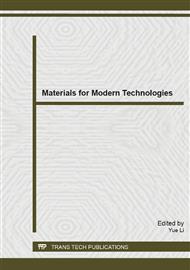[1]
M. DelOlmo, C. Diez, A. Molina, I. deOrbe, J. L. Vilchez, Resolution of phenol, o-cresol, m-cresol and p-cresol mixtures by excitation fluorescence using partial least-squares (PLS) multivariate calibration, Analytica Chimica Acta. 335(1996).
DOI: 10.1016/s0003-2670(96)00350-9
Google Scholar
[2]
H. H. Schobert, C. Song, Chemicals and materials from coal in the 21st century, Fuel. 81(2002) 15-32.
DOI: 10.1016/s0016-2361(00)00203-9
Google Scholar
[3]
S. H. Yun, C. Kim, Y. C. Kim, E. S. Lee, Dewatering of coal tar by heat treatment, Energy & Fuels. 13(1999) 459-464.
DOI: 10.1021/ef980155g
Google Scholar
[4]
C. Karr, P. M. Brown, P. A. Estep, G. L. Humphrey, Identification and Determination of Low-Boiling Phenols in Low Temperature Coal Tar, Analytical Chemistry. 30(1958) 1413-1416.
DOI: 10.1021/ac60140a037
Google Scholar
[5]
Saleh, A. Y. Tremblay, M. A. Dube, Glycerol removal from biodiesel using membrane separation technology, Fuel. 89(2010) 2260-2266.
DOI: 10.1016/j.fuel.2010.04.025
Google Scholar
[6]
D. M. Nevskaia, E. Castillejos-Lopez, A. Guerrero-Ruiz, V. Munoz, Effects of the surface chemistry of carbon materials on the adsorption of phenol-aniline mixtures from water, Carbon. 42(2004) 653-665.
DOI: 10.1016/j.carbon.2004.01.007
Google Scholar
[7]
M. R. Heidari, B. Seghatoleslami, A. Sharifi, M. Mirzaei, Liquid–liquid extraction of aromatics from their mixtures with alkanes using 1-methyl 3-octylimidazolium thiocyanate ionic liquid. J. Chem, Thermodynamics. 54 (2012) 310–315.
DOI: 10.1016/j.jct.2012.05.006
Google Scholar
[8]
D. L. Venter, I. Nieuwoudt, Separation of m-cresol from neutral oils with liquid-liquid extraction. Industrial & Engineering Chemistry Research. 37(1998) 4099-4106.
DOI: 10.1021/ie980147n
Google Scholar
[9]
K. Pang, Y. C. Hou, W. Z. Wu, W. J. Guo, W. Peng, K. N. Marsh, Efficient separation of phenols from oils via forming deep eutectic solvents, Green Chemistry. 14(2012) 2398-2401.
DOI: 10.1039/c2gc35400d
Google Scholar
[10]
Q. W. Yang, Z. J. Wei, H. B. Xing, Q. L. Ren, BrÖnsted acidic ionic liquids as novel catalysts for the hydrolyzation of soybean isoflavone glycosides. Catalysis Communications. 9(2008) 1307–1311.
DOI: 10.1016/j.catcom.2007.11.023
Google Scholar
[11]
S. J. Zhang, X. M. LÜ, et al. Ionic liquids: from fundamentals to application, in: S. J. Zhang, X. M. LÜ, J. Z. Yang (Eds. ), The nature and structure of the ionic liquid, Science Press., Beijing, 2006, p.78.
Google Scholar


